电气PLC英文翻译英文资料DCS&PLC Which Is Better For You
电气常用英语
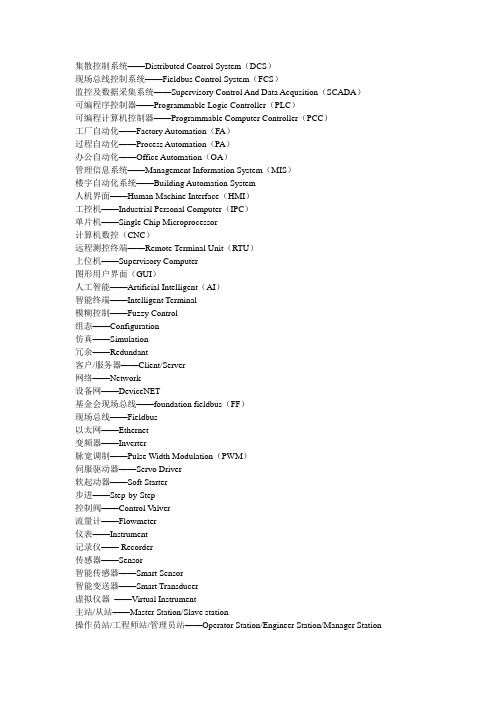
集散控制系统——Distributed Control System(DCS)现场总线控制系统——Fieldbus Control System(FCS)监控及数据采集系统——Supervisory Control And Data Acqusition(SCADA)可编程序控制器——Programmable Logic Controller(PLC)可编程计算机控制器——Programmable Computer Controller(PCC)工厂自动化——Factory Automation(FA)过程自动化——Process Automation(PA)办公自动化——Office Automation(OA)管理信息系统——Management Information System(MIS)楼宇自动化系统——Building Automation System人机界面——Human Machine Interface(HMI)工控机——Industrial Personal Computer(IPC)单片机——Single Chip Microprocessor计算机数控(CNC)远程测控终端——Remote Terminal Unit(RTU)上位机——Supervisory Computer图形用户界面(GUI)人工智能——Artificial Intelligent(AI)智能终端——Intelligent Terminal模糊控制——Fuzzy Control组态——Configuration仿真——Simulation冗余——Redundant客户/服务器——Client/Server网络——Network设备网——DeviceNET基金会现场总线——foundation fieldbus(FF)现场总线——Fieldbus以太网——Ethernet变频器——Inverter脉宽调制——Pulse Width Modulation(PWM)伺服驱动器——Servo Driver软起动器——Soft Starter步进——Step-by-Step控制阀——Control Valver流量计——Flowmeter仪表——Instrument记录仪—— Recorder传感器——Sensor智能传感器——Smart Sensor智能变送器——Smart Transducer虚拟仪器——Virtual Instrument主站/从站——Master Station/Slave station操作员站/工程师站/管理员站——Operator Station/Engineer Station/Manager Station电力系统power system发电机generator励磁excitation励磁器excitor电压voltage电流current升压变压器step-up transformer母线bus变压器transformer空载损耗:no-load loss铁损:iron loss铜损:copper loss空载电流:no-load current无功损耗:reactive loss有功损耗:active loss输电系统power transmission system 高压侧high side输电线transmission line高压: high voltage低压:low voltage中压:middle voltage功角稳定angle stability稳定stability电压稳定voltage stability暂态稳定transient stability电厂power plant能量输送power transfer交流AC直流DC电网power system落点drop point开关站switch station调节regulation高抗high voltage shunt reactor并列的:apposable裕度margin故障fault三相故障three phase fault分接头:tap切机generator triping高顶值high limited value静态static (state)动态dynamic (state)机端电压控制A VR电抗reactance电阻resistance功角power angle有功(功率)active power电容器:Capacitor电抗器:Reactor断路器:Breaker电动机:motor功率因数:power-factor定子:stator阻抗电压:阻抗:impedance功角:power-angle电压等级:voltage grade有功负载: active load/PLoad无功负载:reactive load档位:tap position电阻:resistor电抗:reactance电导:conductance电纳:susceptance上限:upper limit下限:lower limit正序阻抗:positive sequence impedance 负序阻抗:negative sequence impedance 零序阻抗:zero sequence impedance无功(功率)reactive power功率因数power factor无功电流reactive current斜率slope额定rating变比ratio参考值reference value电压互感器PT分接头tap仿真分析simulation analysis下降率droop rate传递函数transfer function框图block diagram受端receive-side同步synchronization保护断路器circuit breaker摇摆swing阻尼damping无刷直流电机:Brusless DC motor刀闸(隔离开关):Isolator机端generator terminal变电站transformer substation永磁同步电机:Permanent-magnet Synchronism Motor异步电机:Asynchronous Motor三绕组变压器:three-column transformer ThrClnTrans双绕组变压器:double-column transformer DblClmnTrans固定串联电容补偿fixed series capacitor compensation双回同杆并架double-circuit lines on the same tower单机无穷大系统one machine - infinity bus system励磁电流:magnetizing current 补偿度degree of compensationElectromagnetic fields电磁场失去同步loss of synchronization装机容量installed capacity无功补偿reactive power compensation故障切除时间fault clearing time极限切除时间critical clearing time强行励磁reinforced excitation并联电容器:shunt capacitor< 下降特性droop characteristics线路补偿器LDC(line drop compensation)电机学Electrical Machinery自动控制理论Automatic Control Theory电磁场Electromagnetic Field微机原理Principle of Microcomputer电工学Electrotechnics Principle of circuits电力系统稳态分析Steady-State Analysis of Power System电力系统暂态分析Transient-State Analysis of Power System电力系统继电保护原理Principle of Electrical System's Relay Protection 电力系统元件保护原理Protection Principle of Power System 's Element 电力系统内部过电压Past V oltage within Power system模拟电子技术基础Basis of Analogue Electronic Technique数字电子技术Digital Electrical Technique电路原理实验Lab. of principle of circuits电气工程讲座Lectures on electrical power production电力电子基础Basic fundamentals of power electronics高电压工程High voltage engineering电子专题实践Topics on experimental project of electronics电气工程概论Introduction to electrical engineering电子电机集成系统electronic machine system电力传动与控制Electrical Drive and Control电力系统继电保护Power System Relaying Protection。
常见英文缩写(DCS、PLC)

HTML—HyperTextMarkupLanguage〔超文本链接标示语言〕CM——ControlModule控制模块SCM——SequentialControlModule顺序控制模块CPM——ControlProcessingModule控制处理模块CEE——ControlExecutionEnvironment控制执行环境CNI——ControlNetInterface控制网络接口C200——Controlprocessor控制处理器RM——RedundancyModule冗余模块IOMs——input/outputModules输入/输出模块SCE——SimulationControlModule模拟控制模块ACE——ApplicationControlModule应用控制模块IOLIM——IOLinkInterfaceModule接口模块FIM——FieldbusInerfaceModule现场总线模块PMIO—ProcessManagerInput/Output流程管理器输入/输出FTA-FieldTerminationAssembliesIOP——Input/OutputProcessor(card)输入/输出处理器〔卡〕ERDB——EngineeringRepositoryDatabase工程数据库EMDB—Enterprisemodeldatabase企业模型数据库RTDB—RealTimeDatabase实时数据库ODBC—OpenDatabaseConnectivity开放式数据库连接SQL—StructuredQueryLanguage 结构化查询语言PV—ProcessValue 工艺价值SCADA—Supervisorycontrolanddataacquisition监督控制和数据采集FTE-faulttolerantEthernet容错以太网CP-controlprocessor控制处理器CNI-controlnetinterface控制网接口FTEB-faulttolerantEthernetbridge容错以太网桥RM-redundancymodule冗余模块FIM-fieldbusinterfacemodule现场总线接口模块OPC-OLEforprocesscontrol用于过程控制ACE-applicationcontrolenvironment〔应用控制环境〕DSA-distributedsystemarchitecture分布式系统架构CEE-controlexecuteenvironment控制执行环境ES-CE--ConsoleExtensionStation控制扩展控制站ES-F--ExperionFlexStationES-C--ExperionConsoleStationFTA--FieldTermination Assembly(for SerialInterface)CDAserver:ContorlDataAccessServer控制数据接入效劳器OPC:OLEforprocesscontrolDSA:disbutedsystemArchitecture分布式系统结构FTE:faulttolerantEthernet 容错以太网RTD:热电阻T/C:热电偶PIM:pulseInputModule 脉冲输入模块SIM:SerialInterfaceModule 串口接口模块SIEMENSPLC常用英语缩写表集散控制系统——DistributedControlSystem 〔DCS〕现场总线控制系统——FieldbusControlSystem〔FCS〕监控及数据采集系统——SupervisoryControlAndDataAcqusition 〔SCADA〕可编程序控制器——ProgrammableLogicController 〔PLC〕可编程计算机控制器——ProgrammableComputerController 〔PCC〕工厂自动化——FactoryAutomation 〔FA〕过程自动化——ProcessAutomation 〔PA〕办公自动化——OfficeAutomation 〔OA〕管理信息系统——ManagementInformationSystem 〔MIS〕楼宇自动化系统——BuildingAutomationSystem人机界面——HumanMachineInterface 〔HMI〕工控机——IndustrialPersonalComputer 〔IPC〕单片机——SingleChipMicroprocessor计算机数控〔CNC〕远程测控终端——RemoteTerminalUnit 〔RTU〕上位机——SupervisoryComputer图形用户界面〔GUI〕人工智能——ArtificialIntelligent 〔AI〕智能终端——IntelligentTerminal模糊控制——FuzzyControl组态——Configuration仿真——Simulation冗余——Redundant客户/效劳器——Client/Server网络——Network设备网——DeviceNET基金会现场总线——foundationfieldbus 〔FF〕现场总线——Fieldbus以太网——Ethernet变频器——Inverter脉宽调制——PulseWidthModulation 〔PWM〕伺服驱动器——ServoDriver软起动器——SoftStarter步进——Step-by-Step控制阀——ControlValver流量计——Flowmeter仪表——Instrument记录仪——Recorder传感器——Sensor智能传感器——SmartSensor智能变送器——SmartTransducer虚拟仪器——VirtualInstrument主站/从站——MasterStation/Slavestation操作员站/工程师站/管理员站——Operator Station/Engineer Station/Manager StationDCS画面常用常用缩写词语1ST1级FRQ频率报警FSH末级过热器ADS自动调度系统FSSS炉膛平安监测系统AGC自动发电机控制FW给水AH空气预热器AS轴向位移GC高压调门控制ATC汽轮机自动控制GEN发电机AUTO自动GV〔高压〕调节汽门AUX辅助的HH高高BASE根本HAV暖通BCP炉水循环泵HDR联箱,集箱BD排污HP高压缸BF锅炉跟随HTR加热器BFP锅炉给水泵IC中压调门控制BMCR锅炉最大连续出力ID标志,标识BMP燃烧器管理系统BOP轴承油泵IMP冲动式〔级〕BP旁路INCR提高,增加BRG轴承INTERM定期,间断BTG锅炉-汽机-发电机IV中压调门切换低低CAF冷却风机LDC负荷指令计算机CAMP控制+报警+监测+保护LOP顶轴油泵CCCW闭式循环冷却水Lp低压CCS协调控制系统LSH低温过热器CDSR凝汽器LUB润滑油COND凝结MANU手动〔方式〕CON连续的MCR最大连续出力COOR连续的MCS模拟量控制系统CORR校正,修正MEH小型汽轮机电液调节CRT显示器MFT主燃料失去保护CRH低温再热器MIN最小CSH包覆过热器MS主蒸汽CW循环水MW兆瓦NO编号,第。
自动化控制英文缩写解释
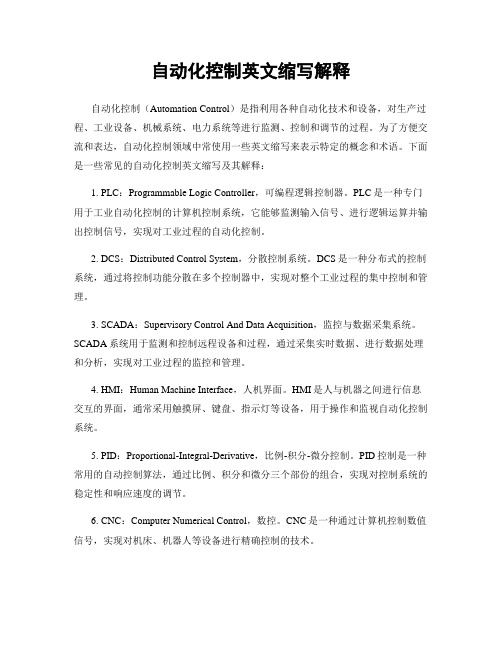
自动化控制英文缩写解释自动化控制(Automation Control)是指利用各种自动化技术和设备,对生产过程、工业设备、机械系统、电力系统等进行监测、控制和调节的过程。
为了方便交流和表达,自动化控制领域中常使用一些英文缩写来表示特定的概念和术语。
下面是一些常见的自动化控制英文缩写及其解释:1. PLC:Programmable Logic Controller,可编程逻辑控制器。
PLC是一种专门用于工业自动化控制的计算机控制系统,它能够监测输入信号、进行逻辑运算并输出控制信号,实现对工业过程的自动化控制。
2. DCS:Distributed Control System,分散控制系统。
DCS是一种分布式的控制系统,通过将控制功能分散在多个控制器中,实现对整个工业过程的集中控制和管理。
3. SCADA:Supervisory Control And Data Acquisition,监控与数据采集系统。
SCADA系统用于监测和控制远程设备和过程,通过采集实时数据、进行数据处理和分析,实现对工业过程的监控和管理。
4. HMI:Human Machine Interface,人机界面。
HMI是人与机器之间进行信息交互的界面,通常采用触摸屏、键盘、指示灯等设备,用于操作和监视自动化控制系统。
5. PID:Proportional-Integral-Derivative,比例-积分-微分控制。
PID控制是一种常用的自动控制算法,通过比例、积分和微分三个部份的组合,实现对控制系统的稳定性和响应速度的调节。
6. CNC:Computer Numerical Control,数控。
CNC是一种通过计算机控制数值信号,实现对机床、机器人等设备进行精确控制的技术。
7. MES:Manufacturing Execution System,创造执行系统。
MES系统用于管理和控制创造过程中的各个环节,包括计划排程、生产监控、质量管理等,实现对创造过程的优化和管理。
自动化常用英文缩写
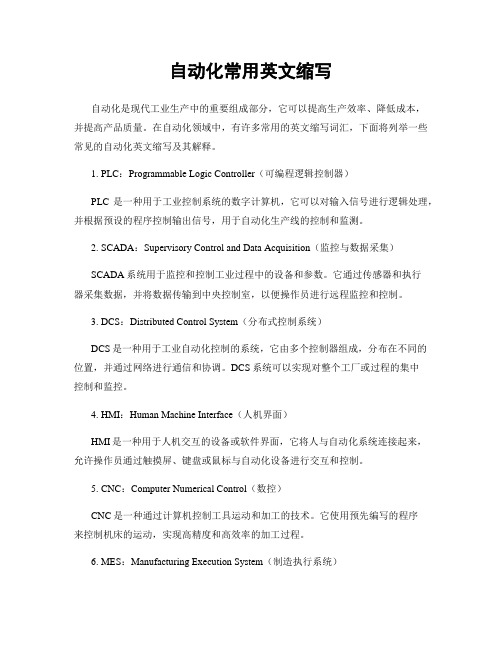
自动化常用英文缩写自动化是现代工业生产中的重要组成部分,它可以提高生产效率、降低成本,并提高产品质量。
在自动化领域中,有许多常用的英文缩写词汇,下面将列举一些常见的自动化英文缩写及其解释。
1. PLC:Programmable Logic Controller(可编程逻辑控制器)PLC是一种用于工业控制系统的数字计算机,它可以对输入信号进行逻辑处理,并根据预设的程序控制输出信号,用于自动化生产线的控制和监测。
2. SCADA:Supervisory Control and Data Acquisition(监控与数据采集)SCADA系统用于监控和控制工业过程中的设备和参数。
它通过传感器和执行器采集数据,并将数据传输到中央控制室,以便操作员进行远程监控和控制。
3. DCS:Distributed Control System(分布式控制系统)DCS是一种用于工业自动化控制的系统,它由多个控制器组成,分布在不同的位置,并通过网络进行通信和协调。
DCS系统可以实现对整个工厂或过程的集中控制和监控。
4. HMI:Human Machine Interface(人机界面)HMI是一种用于人机交互的设备或软件界面,它将人与自动化系统连接起来,允许操作员通过触摸屏、键盘或鼠标与自动化设备进行交互和控制。
5. CNC:Computer Numerical Control(数控)CNC是一种通过计算机控制工具运动和加工的技术。
它使用预先编写的程序来控制机床的运动,实现高精度和高效率的加工过程。
6. MES:Manufacturing Execution System(制造执行系统)MES是一种用于管理和监控制造过程的软件系统。
它可以跟踪和记录生产过程中的各个环节,并提供实时数据和报告,以帮助制造商优化生产计划和资源分配。
7. RFID:Radio Frequency Identification(射频识别)RFID是一种无线通信技术,用于自动识别和跟踪物体。
DCS------PLC

DCS分为三大部分,带I/O板的控制器、通讯网络和人机界面(HMI)。由I/O板通过端子板直接与生产过程相连,读取传感器来的信号。I/O板有几种不同的类型,每一种I/O板都有相应的端子板。
l 模拟量输入,4-20毫安的标准信号板和用以读取热电偶的毫伏信号板;4-16个通道不等;
l 模拟量输出,通常都是4-20毫安的标准信号,一般它的通道比较少,4-8个个通道;
控制器中安装有操作系统控制器一定是冗余运行的,一用一备,并且是热备。为了使冗余成功,应注意以下几点:两个控制器的硬件、软件版本必需一致;检查发送-接收的芯片是否完好;冗余的芯片是否完好。两个模件的设定是否一样、还要检查有没有带手操站等。
通讯网络把过程站和人机界面连成一个系统。通讯网络有几种不同的结构行式。如总线式、环形和星形(见图)。总线形在逻辑上也是环形的。星形的只适用于小系统。不论是环形还是总线形,一般都采用广播式。其它一些协议方式已用的较少。通讯网络的速率在10M和100M左右。
l 现场总线I/O板;
每一块I/O板都接在I/O总线上。为了信号的安全和完整,信号在进入I/O板以前信号要进行整修,如上下限的检查、温度补偿、滤波,这些工作可以在端子板完成,也可以分开完成,完成信号整修的板现在有人称它们为信号调理板。
I/O总线和控制器相连。80年代的DCS由于控制器的运算能力不强,为了增加I/O点数,把控制器的任务分开,实际上是有三种类型的控制器。即:完成闭环运算的控制器、模拟量数据采集器和逻辑运算器。它们分别有自己的I/O总线,各种DCS的I/O总线各不相同。如果要求快速,最好采用并行总线。一般采用串行总线比较多。尤其是RS485总线较多,模拟量数据采集器和逻辑运算器的I/O点数可以多一些。
常见英文缩写DCS、PLC
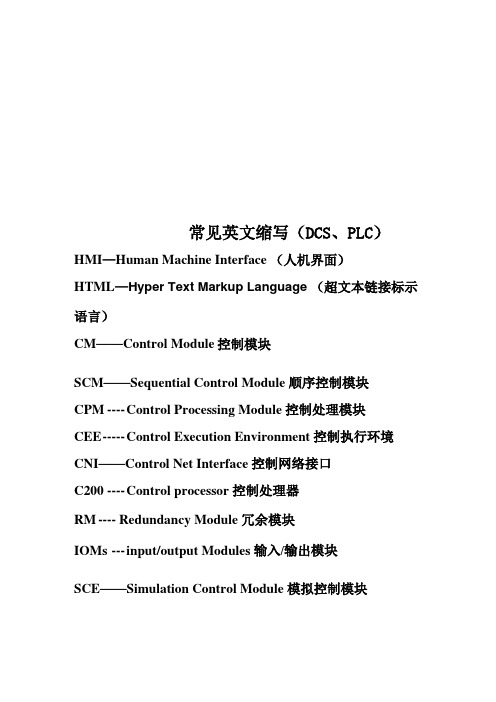
常见英文缩写(DCS、PLC)HMI—Human Machine Interface (人机界面)HTML—Hyper Text Markup Language (超文本链接标示语言)CM——Control Module控制模块SCM——Sequential Control Module 顺序控制模块CPM ---- Control Processing Module 控制处理模块CEE ----- Control Execution Environment 控制执行环境CNI——Control Net Interface 控制网络接口C200 ---- Control processor 控制处理器RM ---- Redundancy Module 冗余模块IOMs --- input/output Modules 输入/输出模块SCE——Simulation Control Module 模拟控制模块ACE ----- Application Control Module 应用控制模块IOLIM——IO Link Interface Module 接口模块FIM ----- Fieldbus Inerface Module 现场总线模块PMIO_Process Manager Input/Output 流程管理器输入/输出FTA-Field Termination AssembliesIOP ------ Input/Output Processor (card)输入/输出处理器(卡)ERDB ---- Engineering Repository Database 工程数据库EMDB—Enterprise model database 企业模型数据库RTDB-Real Time Database 实时数据库ODBC—Open Database Connectivity 开放式数据库连接SQL—Structured Query Language 结构化查询语言PV—Process Value 工艺价值SCADA-Supervisory control and data acquisition监督控制和数据采集FTE-fault tolerant Ethernet 容错以太网CP-control processor 控制处理器CNI-control net interface 控制网接口FTEB-fault tolerant Ethernet bridge 容错以太网桥RM-redundancy module 冗余模块FIM-fieldbus interface module 现场总线接口模块OPC-OLE for process control 用于过程控制ACE-application control environment (应用控制环境) DSA-distributed system architecture 分布式系统架构CEE-control execute environment 控制执行环境ES-CE --Console Extension Station 控制扩展控制站ES-F --Experion Flex StationES-C --Experion Console StationFTA--Field Termination Assembly (for Serial Interface) CDA server :Contorl Data Access Server 控制数据接入服务器OPC:OLE for process controlDSA:disbuted system Architecture 分布式系统结构FTE:fault tolerant Ethernet 容错以太网RTD:热电阻T/C:热电偶PIM:pulse Input Module 脉冲输入模块SIM:Serial Interface Module 串口接口模块SIEMENS PLC常用英语缩写表集散控制系统 -- Distributed Control System(DCS)现场总线控制系统--- Fieldbus ControlSystem (FCS)监控及数据采集系统-- Supervisory Control And Data Acqusition (SCADA)可编程序控制器 -- Programmable LogicController(PLC)可编程计算机控制器-- ProgrammableComputer Controller(PCC)工厂自动化-- Factory Automation(FA)过程自动化-- Process Automation(PA)办公自动化-- Office Automation(OA)管理信息系统-- Management InformationSystem(MIS)楼宇自动化系统 -- Building AutomationSystem人机界面--- Human Machine Interface(HMI)工控机--- Industrial Personal Computer(IPC)单片机--- Single Chip Microprocessor计算机数控(。
自动化常用英文缩写

自动化常用英文缩写引言概述:在自动化领域中,常常出现各种英文缩写词汇,这些缩写词汇在技术交流和文档撰写中起到了重要的作用。
了解这些常用的英文缩写词汇,可以帮助我们更好地理解和应用自动化技术。
本文将介绍一些常用的自动化英文缩写,并详细解释其含义和用途。
一、PLC(Programmable Logic Controller)1.1 硬件层面:PLC是一种专门用于工业自动化控制的可编程逻辑控制器。
它由CPU、存储器、输入/输出模块等组成,可用于控制各种工业过程。
1.2 软件层面:PLC的软件通常由Ladder Diagram(梯形图)或者Structured Text(结构化文本)编写,用于实现各种逻辑控制功能。
1.3 应用领域:PLC广泛应用于工业自动化领域,如生产线控制、机器人控制、电力系统控制等。
二、SCADA(Supervisory Control and Data Acquisition)2.1 监控:SCADA系统用于监控和控制工业过程中的设备和参数。
它可以实时采集数据、显示设备状态,并进行报警和故障处理。
2.2 控制:SCADA系统可以通过远程操作实现对设备的控制,如开关控制、调节参数等。
2.3 数据采集:SCADA系统可以采集各种传感器和仪表的数据,并进行存储和分析,为工程师提供决策依据。
三、HMI(Human Machine Interface)3.1 人机交互:HMI是人与机器之间进行信息交流和操作的界面。
它通常由触摸屏、按钮、指示灯等组成,用于显示设备状态、接收操作指令。
3.2 数据可视化:HMI可以将采集到的数据以图表、曲线等形式直观地展示给操作人员,帮助他们更好地理解设备运行情况。
3.3 报警和故障处理:HMI可以及时报警并显示故障信息,方便工程师进行故障排查和处理。
四、DCS(Distributed Control System)4.1 分布式控制:DCS是一种将控制功能分布在多个控制节点上的系统。
常见英文缩写(DCS、PLC)

常见英文缩写(D C S、P L C)-CAL-FENGHAI-(2020YEAR-YICAI)_JINGBIANHMI—Human Machine Interface(人机界面)HTML—Hyper Text Markup Language(超文本链接标示语言)CM——Control Module控制模块SCM——Sequential Control Module顺序控制模块CPM——Control Processing Module控制处理模块CEE——Control Execution Environment控制执行环境CNI——Control Net Interface控制网络接口C200——Control processor控制处理器RM——Redundancy Module冗余模块IOMs——input/output Modules输入/输出模块SCE——Simulation Control Module模拟控制模块ACE——Application Control Module应用控制模块IOLIM——IO Link Interface Module接口模块FIM——Fieldbus Inerface Module现场总线模块PMIO—Process Manager Input/Output流程管理器输入/输出FTA-Field Termination AssembliesIOP——Input/Output Processor (card) 输入/输出处理器(卡)ERDB——Engineering Repository Database工程数据库EMDB—Enterprise model database企业模型数据库RTDB—Real Time Database实时数据库ODBC—Open Database Connectivity开放式数据库连接SQL—Structured Query Language结构化查询语言PV—Process Value工艺价值SCADA—Supervisory control and data acquisition监督控制和数据采集FTE-fault tolerant Ethernet容错以太网CP-control processor控制处理器CNI-control net interface控制网接口FTEB-fault tolerant Ethernet bridge容错以太网桥RM-redundancy module冗余模块FIM-fieldbus interface module现场总线接口模块OPC-OLE for process control用于过程控制ACE-application control environment(应用控制环境)DSA-distributed system architecture分布式系统架构CEE-control execute environment控制执行环境ES-CE --Console Extension Station控制扩展控制站ES-F --Experion Flex StationES-C --Experion Console StationFTA--Field Termination Assembly (for Serial Interface) CDA server :Contorl Data Access Server 控制数据接入服务器OPC:OLE for process controlDSA:disbuted system Architecture 分布式系统结构FTE:fault tolerant Ethernet??容错以太网RTD:热电阻T/C:热电偶PIM:pulse Input Module 脉冲输入模块SIM:Serial Interface Module 串口接口模块SIEMENS PLC常用英语缩写表集散控制系统——Distributed Control System(DCS)现场总线控制系统——Fieldbus Control System(FCS)监控及数据采集系统——Supervisory Control And Data Acqusition(SCADA)可编程序控制器——Programmable Logic Controller(PLC)可编程计算机控制器——Programmable Computer Controller(PCC)工厂自动化——Factory Automation(FA)过程自动化——Process Automation(PA)办公自动化——Office Automation(OA)管理信息系统——Management Information System(MIS)楼宇自动化系统——Building Automation System人机界面——Human Machine Interface(HMI)工控机——Industrial Personal Computer(IPC)单片机——Single Chip Microprocessor计算机数控(CNC)远程测控终端——Remote Terminal Unit(RTU)上位机——Supervisory Computer图形用户界面(GUI)人工智能——Artificial Intelligent(AI)智能终端——Intelligent Terminal模糊控制——Fuzzy Control组态——Configuration仿真——Simulation冗余——Redundant客户/服务器——Client/Server网络——Network设备网——DeviceNET基金会现场总线——foundation fieldbus(FF)现场总线——Fieldbus以太网——Ethernet变频器——Inverter脉宽调制——Pulse Width Modulation(PWM)伺服驱动器——Servo Driver软起动器——Soft Starter步进——Step-by-Step控制阀——Control Valver流量计——Flowmeter仪表——Instrument记录仪—— Recorder传感器——Sensor智能传感器——Smart Sensor智能变送器——Smart Transducer虚拟仪器——Virtual Instrument主站/从站——Master Station/Slave station操作员站/工程师站/管理员站——Operator Station/Engineer Station/Manager StationDCS画面常用常用缩写词语1ST1级FRQ频率A报警FSH末级过热器ADS自动调度系统FSSS炉膛安全监测系统AGC自动发电机控制FW给水AH空气预热器FWP给水泵AS轴向位移GC高压调门控制ATC汽轮机自动控制GEN发电机AUTO自动GV(高压)调节汽门AUX辅助的HH高高BASE基本HAV暖通BCP炉水循环泵HDR联箱,集箱BD排污HP高压缸BF锅炉跟随HTR加热器BFP锅炉给水泵IC中压调门控制BMCR锅炉最大连续出力ID标志,标识BMP燃烧器管理系统IDF引风机BOP轴承油泵IMP冲动式(级)BP旁路INCR提高,增加BRG轴承INTERM定期,间断BTG锅炉-汽机-发电机IV中压调门C切换LL低低CAF冷却风机LDC负荷指令计算机CAMP控制+报警+监测+保护LOP顶轴油泵CCCW闭式循环冷却水Lp低压CCS协调控制系统LSH低温过热器CDSR凝汽器LUB润滑油COND凝结MANU手动(方式)CON连续的MCR最大连续出力COOR连续的MCS模拟量控制系统CORR校正,修正MEH小型汽轮机电液调节CRT显示器MFT主燃料失去保护CRH低温再热器MIN最小CSH包覆过热器MS主蒸汽CW循环水MW兆瓦D NO编号,第。
自动化控制英文缩写解释

自动化控制英文缩写解释自动化控制是指利用计算机技术和现代控制理论,对生产过程、设备和系统进行自动化监测、调节和控制的一种技术手段。
在自动化控制领域中,有许多常见的英文缩写,下面将对其中一些常见的英文缩写进行解释。
1. PLC (Programmable Logic Controller)PLC是可编程逻辑控制器的缩写。
它是一种专门用于工业自动化控制的计算机控制系统。
PLC能够根据预先设定的程序对输入信号进行逻辑运算和控制输出信号,从而实现对生产过程的自动化控制。
2. DCS (Distributed Control System)DCS是分布式控制系统的缩写。
它是一种用于监控和控制大型工业过程的自动化系统。
DCS系统由多个分布在不同地点的控制单元组成,这些控制单元通过网络连接,实现对整个生产过程的集中控制和监测。
3. SCADA (Supervisory Control and Data Acquisition)SCADA是监控与数据采集的缩写。
它是一种用于监控、采集和控制远程设备和系统的技术。
SCADA系统通过传感器和执行器与远程设备进行通信,将实时数据传输到监控中心,操作员可以通过监控中心对远程设备进行监测和控制。
4. HMI (Human Machine Interface)HMI是人机界面的缩写。
它是一种用于人机交互的技术,通过图形化界面和操作控制设备,使操作员能够直观地监控和控制自动化系统。
HMI通常包括触摸屏、键盘、指示灯等设备,操作员可以通过这些设备与自动化系统进行交互。
5. PID (Proportional-Integral-Derivative)PID是比例-积分-微分的缩写。
它是一种常用的控制算法,用于调节和控制自动化系统的输出。
PID控制器根据当前的偏差和变化率,计算出输出信号,从而实现对系统的精确控制。
6. CNC (Computer Numerical Control)CNC是计算机数控的缩写。
自动化控制英文缩写解释
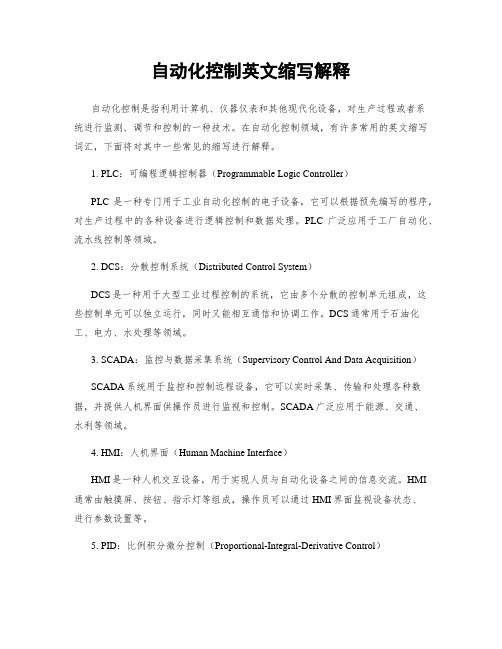
自动化控制英文缩写解释自动化控制是指利用计算机、仪器仪表和其他现代化设备,对生产过程或者系统进行监测、调节和控制的一种技术。
在自动化控制领域,有许多常用的英文缩写词汇,下面将对其中一些常见的缩写进行解释。
1. PLC:可编程逻辑控制器(Programmable Logic Controller)PLC是一种专门用于工业自动化控制的电子设备,它可以根据预先编写的程序,对生产过程中的各种设备进行逻辑控制和数据处理。
PLC广泛应用于工厂自动化、流水线控制等领域。
2. DCS:分散控制系统(Distributed Control System)DCS是一种用于大型工业过程控制的系统,它由多个分散的控制单元组成,这些控制单元可以独立运行,同时又能相互通信和协调工作。
DCS通常用于石油化工、电力、水处理等领域。
3. SCADA:监控与数据采集系统(Supervisory Control And Data Acquisition)SCADA系统用于监控和控制远程设备,它可以实时采集、传输和处理各种数据,并提供人机界面供操作员进行监视和控制。
SCADA广泛应用于能源、交通、水利等领域。
4. HMI:人机界面(Human Machine Interface)HMI是一种人机交互设备,用于实现人员与自动化设备之间的信息交流。
HMI通常由触摸屏、按钮、指示灯等组成,操作员可以通过HMI界面监视设备状态、进行参数设置等。
5. PID:比例积分微分控制(Proportional-Integral-Derivative Control)PID控制是一种常用的自动控制算法,它通过比较实际值和设定值之间的差异,根据比例、积分和微分的关系来调整控制器的输出,使得系统能够快速而稳定地达到设定目标。
6. CNC:数控系统(Computer Numerical Control)CNC系统是一种用于控制机床和其他工业设备的自动化系统,它通过预先编写的程序,控制工具的运动轨迹和加工参数,实现精确的加工操作。
自动化常用英文缩写

自动化常用英文缩写一、引言自动化是现代工程技术的重要组成部分,它在各个行业中发挥着重要作用。
在自动化领域中,有许多常用的英文缩写词汇,本文将对一些常见的自动化英文缩写进行详细介绍。
二、常用英文缩写列表及解释1. PLC - Programmable Logic Controller(可编程逻辑控制器)PLC是一种用于控制工业过程的数字计算机。
它可以监测输入信号并根据预设的程序进行逻辑运算,然后输出控制信号,实现对设备和过程的自动化控制。
2. SCADA - Supervisory Control and Data Acquisition(监控与数据采集系统)SCADA系统用于监视和控制工业过程中的设备和参数。
它可以通过传感器采集数据,并将数据传输到监控中心。
监控中心可以对数据进行分析和处理,并通过控制信号实现对设备的远程控制。
3. HMI - Human Machine Interface(人机界面)HMI是一种用于人机交互的设备,通常包括触摸屏、键盘和显示器。
它可以提供直观的操作界面,使操作人员能够轻松地与自动化系统进行交互和控制。
4. DCS - Distributed Control System(分布式控制系统)DCS是一种用于控制和监视工业过程的系统。
它由多个分布式控制器组成,这些控制器可以独立运行,并通过网络进行通信和协调。
DCS系统具有高度的可靠性和灵活性,适用于大规模的工业自动化应用。
5. CNC - Computer Numerical Control(计算机数控)CNC是一种用于控制机床和工业机器人的技术。
它通过计算机程序控制机床的运动和操作,实现对工件的精确加工和控制。
6. MES - Manufacturing Execution System(制造执行系统)MES是一种用于管理和控制制造过程的系统。
它可以监测生产线上的实时数据,并提供生产计划、质量管理和物料追踪等功能,以提高生产效率和质量。
常见英文缩写(DCS、PLC)
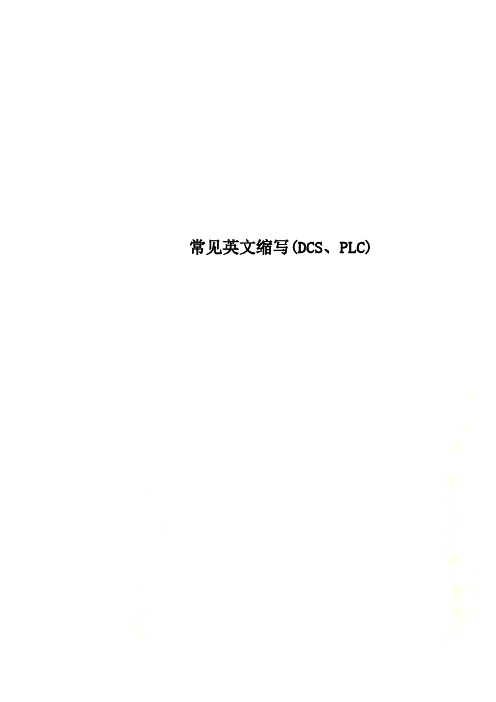
常见英文缩写(DCS、PLC)HMI—Human Machine Interface(人机界面)HTML—Hyper Text Markup Language(超文本链接标示语言)CM——Control Module控制模块SCM——Sequential Control Module顺序控制模块CPM——Control Processing Module控制处理模块CEE——Control Execution Environment控制执行环境CNI——Control Net Interface控制网络接口C200——Control processor控制处理器RM——Redundancy Module冗余模块IOMs——input/output Modules输入/输出模块SCE——Simulation Control Module模拟控制模块ACE——Application Control Module应用控制模块IOLIM——IO Link Interface Module接口模块FIM——Fieldbus Inerface Module现场总线模块PMIO—Process Manager Input/Output流程管理器输入/输出FTA-Field Termination AssembliesIOP——Input/Output Processor (card)输入/输出处理器(卡)ERDB——Engineering Repository Database工程数据库EMDB—Enterprise model database企业模型数据库RTDB—Real Time Database实时数据库ODBC—Open Database Connectivity开放式数据库连接SQL—Structured Query Language结构化查询语言PV—Process Value工艺价值SCADA—Supervisory control and data acquisition监督控制和数据采集FTE-fault tolerant Ethernet容错以太网CP-control processor控制处理器CNI-control net interface控制网接口FTEB-fault tolerant Ethernet bridge容错以太网桥RM-redundancy module冗余模块FIM-fieldbus interface module现场总线接口模块OPC-OLE for process control用于过程控制ACE-application control environment(应用控制环境)DSA-distributed system architecture分布式系统架构CEE-control execute environment控制执行环境ES-CE --Console Extension Station控制扩展控制站ES-F --Experion Flex StationES-C --Experion Console StationFTA--Field Termination Assembly (for Serial Interface) CDA server :Contorl Data Access Server 控制数据接入服务器OPC:OLE for process controlDSA:disbuted system Architecture 分布式系统结构FTE:fault tolerant Ethernet 容错以太网RTD:热电阻T/C:热电偶PIM:pulse Input Module 脉冲输入模块SIM:Serial Interface Module 串口接口模块SIEMENS PLC常用英语缩写表集散控制系统——Distributed Control System(DCS)现场总线控制系统——Fieldbus ControlSystem(FCS)监控及数据采集系统——Supervisory Control And Data Acqusition(SCADA)可编程序控制器——Programmable LogicController(PLC)可编程计算机控制器——Programmable Computer Controller(PCC)工厂自动化——Factory Automation(FA)过程自动化——Process Automation(PA)办公自动化——Office Automation(OA)管理信息系统——Management InformationSystem(MIS)楼宇自动化系统——Building AutomationSystem人机界面——Human Machine Interface(HMI)工控机——Industrial Personal Computer(IPC)单片机——Single Chip Microprocessor计算机数控(CNC)远程测控终端——Remote Terminal Unit(RTU)上位机——Supervisory Computer图形用户界面(GUI)人工智能——Artificial Intelligent(AI)智能终端——Intelligent Terminal模糊控制——Fuzzy Control组态——Configuration仿真——Simulation冗余——Redundant客户/服务器——Client/Server网络——Network设备网——DeviceNET基金会现场总线——foundation fieldbus(FF)现场总线——Fieldbus以太网——Ethernet变频器——Inverter脉宽调制——Pulse Width Modulation(PWM)伺服驱动器——Servo Driver软起动器——Soft Starter步进——Step-by-Step控制阀——Control Valver流量计——Flowmeter仪表——Instrument记录仪—— Recorder传感器——Sensor智能传感器——Smart Sensor智能变送器——Smart Transducer虚拟仪器——Virtual Instrument 主站/从站——Master Station/Slave station 操作员站/工程师站/管理员站——Operator Station/Engineer Station/Manager StationDCS画面常用常用缩写词语1ST1级FRQ频率A报警FSH末级过热器ADS自动调度系统FSSS炉膛安全监测系统AGC自动发电机控制FW给水AH空气预热器FWP给水泵AS轴向位移GC高压调门控制ATC汽轮机自动控制GEN发电机AUTO自动GV(高压)调节汽门AUX辅助的HH高高BASE基本HAV暖通BCP炉水循环泵HDR联箱,集箱BD排污HP高压缸BF锅炉跟随HTR加热器BFP锅炉给水泵IC中压调门控制BMCR锅炉最大连续出力ID标志,标识BMP燃烧器管理系统IDF引风机BOP轴承油泵IMP冲动式(级)BP旁路INCR提高,增加BRG轴承INTERM定期,间断BTG锅炉-汽机-发电机IV中压调门C切换LL低低CAF冷却风机LDC负荷指令计算机CAMP控制+报警+监测+保护LOP顶轴油泵CCCW闭式循环冷却水Lp低压CCS协调控制系统LSH低温过热器CDSR凝汽器LUB润滑油COND凝结MANU手动(方式)CON连续的MCR最大连续出力COOR连续的MCS模拟量控制系统CORR校正,修正MEH小型汽轮机电液调节CRT显示器MFT主燃料失去保护CRH低温再热器MIN最小CSH包覆过热器MS主蒸汽CW循环水MW兆瓦D NO编号,第。
常见英文缩写(DCS、PLC)

HMI—Human Machine Interface〔人机界面〕HTML—Hyper Text Markup Language〔超文本链接标示语言〕CM——Control Module控制模块SCM——Sequential Control Module顺序控制模块CPM——Control Processing Module控制处理模块CEE——Control Execution Environment控制执行环境CNI——Control Net Interface控制网络接口C200——Control processor控制处理器RM——Redundancy Module冗余模块IOMs——input/output Modules输入/输出模块SCE——Simulation Control Module模拟控制模块ACE——Application Control Module应用控制模块IOLIM——IO Link Interface Module接口模块FIM——Fieldbus Inerface Module现场总线模块PMIO—Process Manager Input/Output流程管理器输入/输出FTA-Field Termination AssembliesIOP——Input/Output Processor (card)输入/输出处理器〔卡〕ERDB——Engineering Repository Database工程数据库EMDB—Enterprise model database企业模型数据库RTDB—Real Time Database实时数据库ODBC—Open Database Connectivity开放式数据库连接SQL—Structured Query Language结构化查询语言PV—Process Value工艺价值SCADA—Supervisory control and data acquisition监督控制和数据采集FTE-fault tolerant Ethernet容错以太网CP-control processor控制处理器CNI-control net interface控制网接口FTEB-fault tolerant Ethernet bridge容错以太网桥RM-redundancy module冗余模块FIM-fieldbus interface module现场总线接口模块OPC-OLE for process control用于过程控制ACE-application control environment〔应用控制环境〕DSA-distributed system architecture分布式系统架构CEE-control execute environment控制执行环境ES-CE --Console Extension Station控制扩展控制站ES-F --Experion Flex StationES-C --Experion Console StationFTA--Field Termination Assembly (for Serial Interface) CDA server :Contorl Data Access Server 控制数据接入服务器OPC:OLE for process controlDSA:disbuted system Architecture 分布式系统结构FTE:fault tolerant Ethernet 容错以太网RTD:热电阻T/C:热电偶PIM:pulse Input Module 脉冲输入模块SIM:Serial Interface Module 串口接口模块SIEMENS PLC常用英语缩写表集散控制系统——Distributed Control System〔DCS〕现场总线控制系统——Fieldbus Control System〔FCS〕监控及数据采集系统——Supervisory Control And Data Acqusition〔SCADA〕可编程序控制器——Programmable Logic Controller〔PLC〕可编程电脑控制器——Programmable Computer Controller〔PCC〕工厂自动化——Factory Automation〔FA〕过程自动化——Process Automation〔PA〕办公自动化——Office Automation〔OA〕管理信息系统——Management Information System〔MIS〕楼宇自动化系统——Building Automation System人机界面——Human Machine Interface〔HMI〕工控机——Industrial Personal Computer〔IPC〕单片机——Single Chip Microprocessor电脑数控〔CNC〕远程测控终端——Remote Terminal Unit〔RTU〕上位机——Supervisory Computer图形用户界面〔GUI〕人工智能——Artificial Intelligent〔AI〕智能终端——Intelligent Terminal模糊控制——Fuzzy Control组态——Configuration仿真——Simulation冗余——Redundant客户/服务器——Client/Server网络——Network设备网——DeviceNET基金会现场总线——foundation fieldbus〔FF〕现场总线——Fieldbus以太网——Ethernet变频器——Inverter脉宽调制——Pulse Width Modulation〔PWM〕伺服驱动器——Servo Driver软起动器——Soft Starter步进——Step-by-Step控制阀——Control Valver流量计——Flowmeter仪表——Instrument记录仪—— Recorder传感器——Sensor智能传感器——Smart Sensor智能变送器——Smart Transducer虚拟仪器——Virtual Instrument主站/从站——Master Station/Slave station操作员站/工程师站/管理员站——Operator Station/Engineer Station/Manager StationDCS画面常用常用缩写词语1ST1级FRQ频率A报警FSH末级过热器ADS自动调度系统FSSS炉膛安全监测系统AGC自动发电机控制FW给水AH空气预热器FWP给水泵AS轴向位移GC高压调门控制ATC汽轮机自动控制GEN发电机AUTO自动GV〔高压〕调节汽门AUX辅助的HH高高BASE基本HAV暖通BCP炉水循环泵HDR联箱,集箱BD排污HP高压缸BF锅炉跟随HTR加热器BFP锅炉给水泵IC中压调门控制BMCR锅炉最大连续出力ID标志,标识BMP燃烧器管理系统IDF引风机BOP轴承油泵IMP冲动式〔级〕BP旁路INCR提高,增加BRG轴承INTERM定期,间断BTG锅炉-汽机-发电机IV中压调门C切换LL低低CAF冷却风机LDC负荷指令电脑CAMP控制+报警+监测+保护LOP顶轴油泵CCCW闭式循环冷却水Lp低压CCS协调控制系统LSH低温过热器CDSR凝汽器LUB润滑油COND凝结MANU手动〔方式〕CON连续的MCR最大连续出力COOR连续的MCS模拟量控制系统CORR校正,修正MEH小型汽轮机电液调节CRT显示器MFT主燃料失去保护CRH低温再热器MIN最小CSH包覆过热器MS主蒸汽CW循环水MW兆瓦D NO编号,第。
电气专业关于DCS-PLC-MCC等等相关的专业英文全称及功能说明_0

电气专业关于DCS/PLC/MCC等等相关的专业英文全称及功能说明DCS:Distributed Control System;MCC: Motor Control CenterPC: Power Control PanelUPS: Uninterrupted Power Supply1、什么是DCS?DCS是分布式控制系统的英文缩写(Distributed Control System),在国内自控行业又称之为集散控制系统。
2、DCS有什么特点?DCS是计算机技术、控制技术和网络技术高度结合的产物。
DCS通常采用若干个控制器(过程站)对一个生产过程中的众多控制点进行控制,各控制器间通过网络连接并可进行数据交换。
操作采用计算机操作站,通过网络与控制器连接,收集生产数据,传达操作指令。
因此,DCS的主要特点归结为一句话就是:分散控制集中管理。
3、DCS的结构是怎样的?从结构上划分,DCS包括过程级、操作级和管理级。
过程级主要由过程控制站、I/O单元和现场仪表组成,是系统控制功能的主要实施部分。
操作级包括:操作员站和工程师站,完成系统的操作和组态。
管理级主要是指工厂管理信息系统(MIS系统),作为DCS更高层次的应用。
4、DCS的控制程序是由谁执行的?DCS的控制决策是由过程控制站完成的,所以控制程序是由过程控制站执行的。
5、过程控制站的组成如何?DCS的过程控制站是一个完整的计算机系统,主要由电源、CPU(中央处理器)、网络接口和I/O组成。
6、I/O是什么?控制系统需要建立信号的输入和输出通道,这就是I/O。
DCS中的I/O一般是模块化的,一个I/O模块上有一个或多个I/O通道,用来连接传感器和执行器(调节阀)。
7、什么是I/O单元?通常,一个过程控制站是有几个机架组成,每个机架可以摆放一定数量的模块。
CPU所在的机架被称为CPU单元,同一个过程站中只能有一个CPU单元,其他只用来摆放I/O模块的机架就是I/O单元。
DCS与PLC
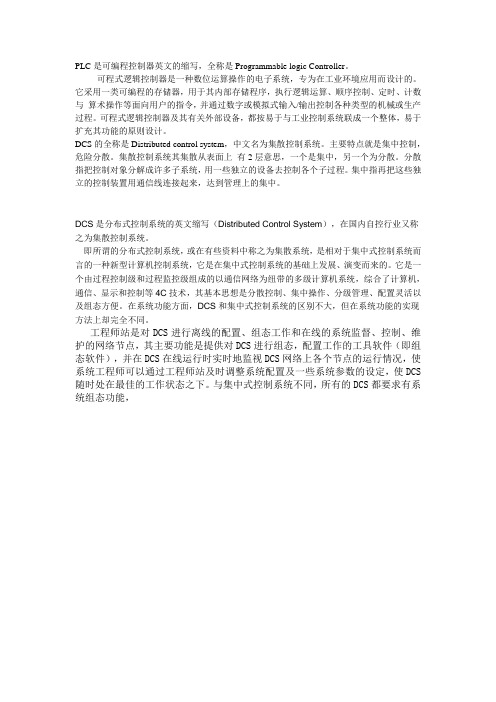
PLC是可编程控制器英文的缩写,全称是Programmable logic Controller。
可程式逻辑控制器是一种数位运算操作的电子系统,专为在工业环境应用而设计的。
它采用一类可编程的存储器,用于其内部存储程序,执行逻辑运算、顺序控制、定时、计数与算术操作等面向用户的指令,并通过数字或模拟式输入/输出控制各种类型的机械或生产过程。
可程式逻辑控制器及其有关外部设备,都按易于与工业控制系统联成一个整体,易于扩充其功能的原则设计。
DCS的全称是Distributed control system,中文名为集散控制系统。
主要特点就是集中控制,危险分散。
集散控制系统其集散从表面上有2层意思,一个是集中,另一个为分散。
分散指把控制对象分解成许多子系统,用一些独立的设备去控制各个子过程。
集中指再把这些独立的控制装置用通信线连接起来,达到管理上的集中。
DCS是分布式控制系统的英文缩写(Distributed Control System),在国内自控行业又称之为集散控制系统。
即所谓的分布式控制系统,或在有些资料中称之为集散系统,是相对于集中式控制系统而言的一种新型计算机控制系统,它是在集中式控制系统的基础上发展、演变而来的。
它是一个由过程控制级和过程监控级组成的以通信网络为纽带的多级计算机系统,综合了计算机,通信、显示和控制等4C技术,其基本思想是分散控制、集中操作、分级管理、配置灵活以及组态方便。
在系统功能方面,DCS和集中式控制系统的区别不大,但在系统功能的实现方法上却完全不同。
工程师站是对DCS进行离线的配置、组态工作和在线的系统监督、控制、维护的网络节点,其主要功能是提供对DCS进行组态,配置工作的工具软件(即组态软件),并在DCS在线运行时实时地监视DCS网络上各个节点的运行情况,使系统工程师可以通过工程师站及时调整系统配置及一些系统参数的设定,使DCS 随时处在最佳的工作状态之下。
与集中式控制系统不同,所有的DCS都要求有系统组态功能,。
- 1、下载文档前请自行甄别文档内容的完整性,平台不提供额外的编辑、内容补充、找答案等附加服务。
- 2、"仅部分预览"的文档,不可在线预览部分如存在完整性等问题,可反馈申请退款(可完整预览的文档不适用该条件!)。
- 3、如文档侵犯您的权益,请联系客服反馈,我们会尽快为您处理(人工客服工作时间:9:00-18:30)。
You must automate a process, but you can't decide between a DCS and a PLC. Are these systems really all that different? The answers depend on a slew of other questions.turn the clock back 10 years: The programmable logic controller (PLC) is king of machine control while the distributed control system (DCS) dominates process control. If you manufacture plastic widgets, you speak PLC. If you produce chemicals, you speak DCS.Today, the two technologies share kingdoms as the functional lines between them continue to blur. We now use each where the other used to rule. However, PLCs still dominate high-speed machine control, and DCSs prevail in complex continuous processes.The early DCS looked dramatically different from the early PLC (Fig. 1, original article). Initially, the DCS performed the control functions of the analog panel instruments it replaced, and its interface mimicked their panel displays. DCSs then gained sequence logic capabilities to control batch processes as well as continuous ones. DCSs performed hundreds of analog measurements and controlled dozens of analog outputs, usingmulti-variable Proportional Integral Derivative (PID) control. With the same 8-bit microprocessor technology that gave rise to the DCS, PLCs began replacing conventional relay/solid-state logic in machine control. PLCs dealt with contact input/output (I/O) and started/stopped motors by performing Boolean logic calculations.Fig. 2 (original article ) gives a Venn-diagrammatic picture of the situation, which is still changing as PLC and DCS vendors adapt to "soft" PLC technology and "smart"bus-connected field devices.The big change in DCS over the past 20 years is its move from proprietary hardware to the personal computer (PC) and standard LAN technologies. With each advance in PC power, DCSs have moved up in power. PCs gave us speedy, responsive, multi-media, windowed, operator-process interfaces (OPI). Relational databases and spreadsheet software enhance the ability of DCSs to store and manipulate data. Artificial intelligence (AI) technology gives us "smart" alarming. Today's DCS architecturally looks much like the DCS of 20 years ago, but tomorrow's DCS may control through networked "smart" devices-with no I/O hardware of its own.The sidebar (original article) shows DCS features that differentiate it from the PLC. Most DCSs offer redundant controllers, networks, and I/Os. Most give you "built-in" redundancy and diagnostic features, with no need for user-written logic.DCSs allow centralized configuration from the operator or engineering console in thecontrol room. You can change programming offline, and download without restarting the system for the change to be effective.DCSs allow inter-controller communications. You can do data exchange in most DCS systems ad hoc (no need for predefined data point lists). You access data by tag name, regardless of hardware or location.DCSs use multi-tasking operating systems, so you can download and run applications aside from the real-time control functions and still do fractional-second control. DCSs now come in "micro" systems, to price-compete with PLCs-but with full DCS features and capabilities.The typical DCS has integrated diagnostics and standard display templates that automatically extend/update when your database changes. This database is central to the system-you don't have different databases sitting in the controllers.DCSs have user-friendly configuration tools, including structured English, control block libraries, SFC (sequential function chart), and even RLL (relay ladder logic).Most DCSs allow graphical configuration, provide online diagnostics, and areself-documenting. Most provide for user-defined control blocks or customized strategies. The controllers execute control strategies as independent tasks; thus, making changes to part of the control logic has no impact on the rest.An important difference between DCSs and PLCs is how vendors market them. DCS vendors typically sell a complete, working, integrated, and tested system; offering full application implementation. They offer many services: training, installation, field service, and integration with your Information Technology (IT) systems. A DCS vendor provides a server with a relational database, a LAN with PCs for office automation, networking support and integration of third-party applications and systems. The DCS vendor tries to be your "one-stop shop." The PLC is more of a "do-it-yourself" device, which is sometimes simpler to execute.Programmable Logic Controllers. When PLCs were solely replacements for hard-wired relays, they had only digital I/O, with no operator interface or communications. Simple operator interfaces appeared, then evolved into increasingly complex interfaces as PLCs worked with increasingly complex automation problems. We went from a panel of buttons and I/O-driven lamps to PLC full-color customized graphic displays that run on SCADA software over a network.PLCs now have many DCS-like control functions (e.g., PID algorithms) and analog I/O. They've moved past their birthplace: the digital world (switch and binary sensor inputs and output contacts to run motors and trigger solenoids).PLCs are fast: They run an input-compute-output cycle in milliseconds. On the other hand, DCSs offer fractional second (1/2 to 1/10) control cycles. However, some DCSs provide interrupt/event-triggered logic for high-speed applications.PLCs are simple, rugged computers with minimal peripherals and simple OSs. While increasing reliability, PLC simplicity is not conducive to redundancy. Thus, fully redundant ("hot," automatic, bumpless) variations of PLCs, with their added hardware and software, sometimes suffer from a reduction in their reliability-a characteristic PLCs are famous for.Data exchange typically requires you to preassign data registers and hard code their addresses into the logic. If you add registers or need to reassign data, you typically have to deal manually with the Domino Effect.Typical PLC Relay Ladder Logic (RLL) languages include function blocks that can perform complex control and math functions (e.g., PID algorithms). Complex multi-loop control functions (e.g., cascade management and loop initialization) are not typical. For functions too messy to implement in RLL, most PLCs provide a function block that calls a user-written program (usually in BASIC or C).PLCs typically operate as "state" machines: They read all inputs, execute through the logic, and then drive the outputs. The user-written logic is typically one big RLL program, which means you may have to take the whole PLC off-line to make a change of any size. You also run into database synchronization problems because of the separation of PLCs and the Man Machine Interface (MMI) software packages, as opposed to the central databases of DCSs.A PLC will run in a stand-alone configuration. A DCS controller normally expects an operator interface and communications, so it can send alarms, messages, trend updates, and display updates.Many PLC installations use interface software from third-party vendors for improved graphics and various levels of alarming, trending, and reporting. The PLC and MMI software normally interact by sitting on the network and using the register exchange mechanism to get data from and to the various PLCs. This type of communication presumes you have preassigned data registers and can fetch data on an absolute addressbasis. This can lead to data processing errors (e.g., from the wrong input) you won't encounter with the central database of a DCS.Some PLCs use proprietary networks, and others can use LANs. Either way, the communication functions are the same-fetch and put registers. This can result in bottlenecking and timing problems if too many PCs try communicating with too many PLCs over a network.Comparison of features and limitations. The Table (original article) compares the features and functions of a DCS and PLC. Given the wide range of customization and new development, these comparisons are generic. The ratings are not a simple "Yes/No" but rather an indication of how each supports these features, relative to an "idealized" model. Cars are generally more comfortable than pickup trucks, but you can modify a pickup to be as comfortable as some cars. We usually select a car over a truck when comfort is what we are looking for. You may find a DCS or PLC is a "comfortable truck." Obviously, the table doesn't quite agree with this, but the ratings are helpful, given the diversity of the various vendors' products.Today, the decision between PLC and DCS often depends on business issues rather than technical features. Questions to consider are those involving:The internal expertise to execute the project,Level of support available from a vendor/integrator,Long-term maintainability, andLife-cycle costs.PLCs and DCSs overlap in their features, but also have distinct strengths and weaknesses. When deciding between the two, know who will deliver and support your system, and how they will do it.A PLC may have a third-party package for operator interfaces, LAN interface to PCs and peripherals, PLC data highway or bus, redundant controllers with local and distributed I/O, local MMI and local programming capability. The PLC would have redundant media support, but not the redundant communication hardware or I/O bus hardware you'd find in a DCS. A PLC would have preprogrammed I/O cards for specific signal types and ranges.。
